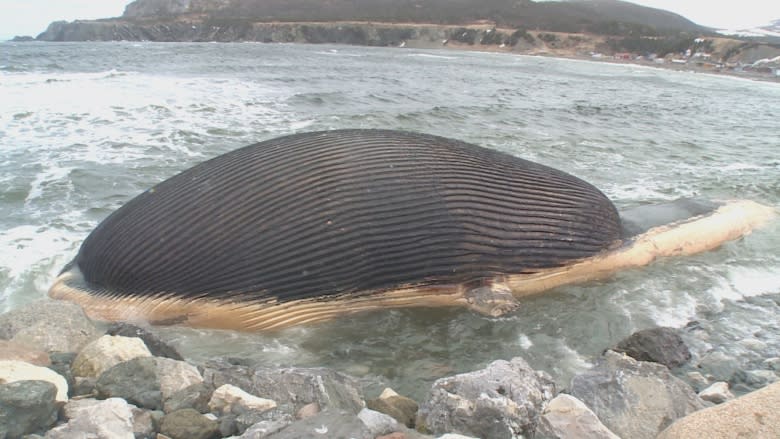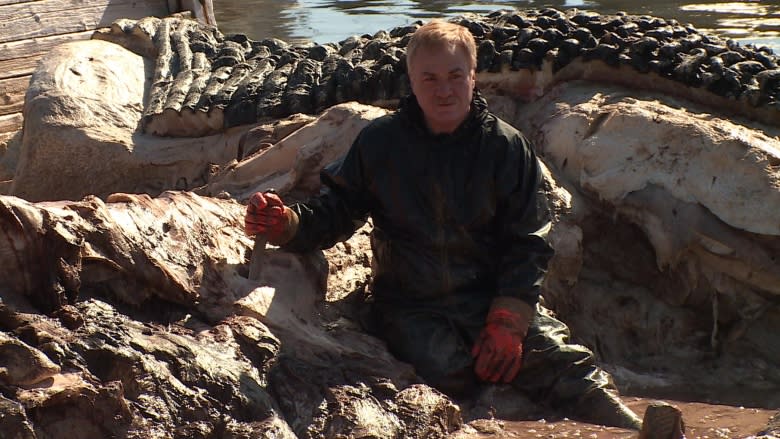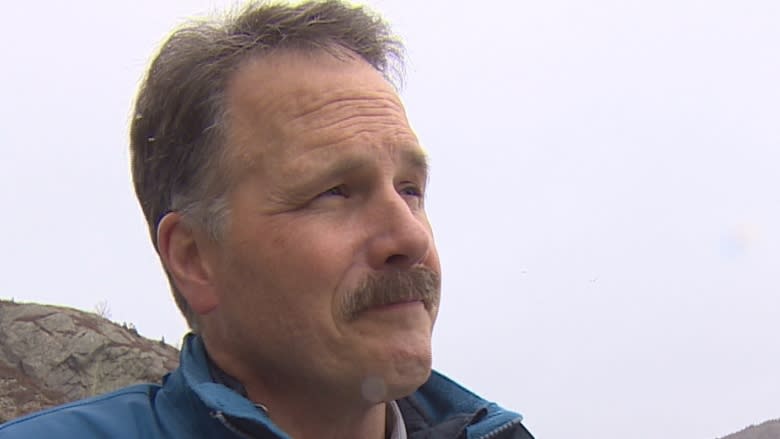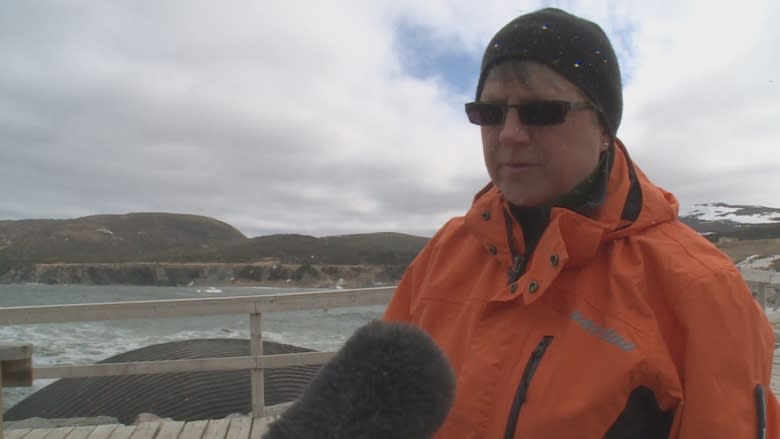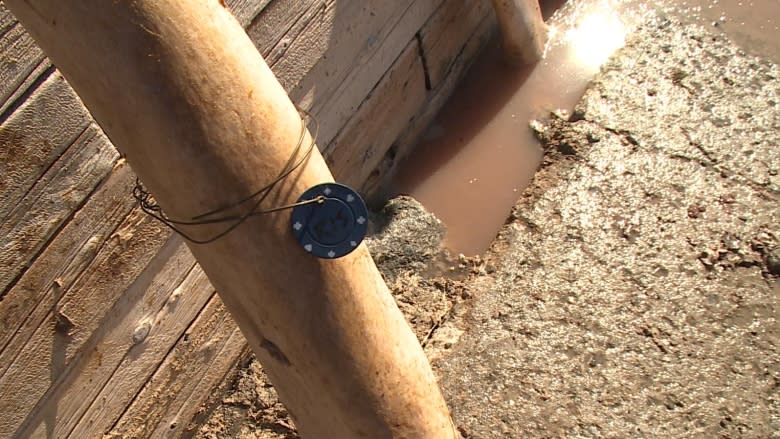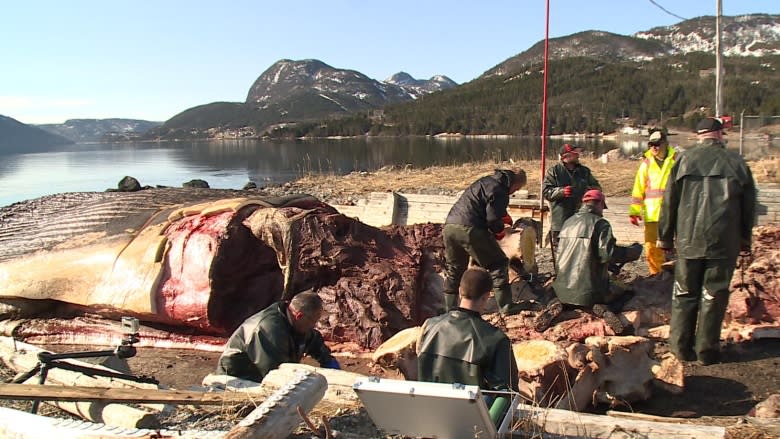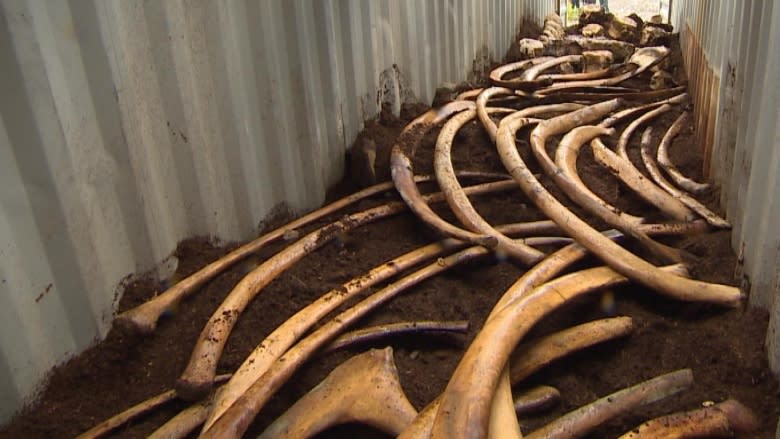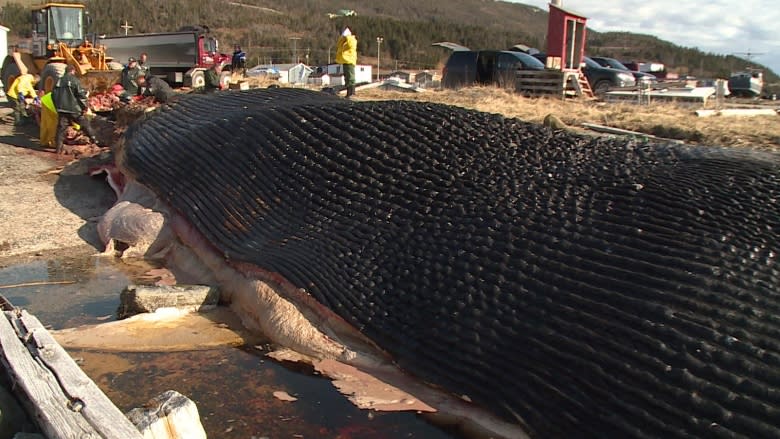Famous blue whale gets own show at Royal Ontario Museum
What is considered by some to be the world's most famous dead whale will get a second life as its skeleton goes on display March 11 at the Royal Ontario Museum in Toronto.
Less than three years after a bloated carcass rolled onto a beach in Trout River, N.L., it has been stripped of fat and blubber, driven 1,700 kilometres, studied, buried in dirt and now mounted for public viewing.
It took a lot to get here.
Crews spent weeks knee-deep in whale guts, hacking away tonnes of blubber to remove the bones and a 180-kilogram heart, all the while learning a lot about the endangered animal.
It's a story that started with thick, heavy sea ice during the winter of 2014 — February, to be exact, when the Department of Fisheries and Oceans noticed the carcasses of at least nine blue whales in the Gulf of St. Lawrence just off the southwestern coast of Newfoundland.
The world's largest animals — 25 metres long — lay lifeless and tiny, compared with the massive mounds of sea ice that surrounded them.
It was a big blow to an endangered species.
The Department of Fisheries and Oceans said the blue whale population in the western North Atlantic is estimated at about 250, so these dead blue whales represented about four per cent of the mammals.
"It's horrible and it's so disappointing for us, because the department is working hard to develop a recovery plan for the species," DFO scientist Jack Lawson told CBC News at the time.
"We are trying to monitor manmade threats like seismic or vessel strikes and that kind of thing, and then to have a natural event like this happen, you really have no control over it and it's pretty shocking."
Trout River whale makes Saturday Night Live
In April 2014, two of the blue whales killed off the southwestern coast off the island of Newfoundland washed ashore; one in Rocky Harbour and the second, more well-known, in Trout River.
The Trout River whale quickly bloated as it started decomposing while floating on the local beach, thanks to a buildup of gas.
Pictures of the inflated whale made international news with the BBC, CNN, among others, all wondering out loud: Could the blue whale explode?
Highly unlikely, Lawson said.
"But I wouldn't encourage anyone with a large knife to try cutting it."
While many around the world waited for the bloated whale to pop, it never did.
Whales are big business in Trout River — mainly for watching the living ones — but this dead blue whale became a tourist attraction that nobody really wanted around.
"Normally we advertise whales to get people to come," Jenny Parsons, owner of the Seaside Restaurant, said in April 2014.
"The restaurant is right on the beach, and we often have whales in the cove frolicking about, but we don't want a dead whale as an attraction."
As time passed the stench began to grow. A plan needed to be put into place, but the question came down to who would pay. The province, the federally funded DFO, or the municipality that became the (un)lucky owner of the whale.
While debate carried on, Saturday Night Live ran a beach-themed sketch featuring the dead whale carcass.
ROM to the rescue
The Royal Ontario Museum agreed to take the two whales and chop them up in the name of science.
Mark Engstrom, the ROM's senior curator and deputy director of collections and research, headed up the project and told reporters when he arrived in Newfoundland that he had been searching for more than a decade for a whale like this one.
Flensing the world's biggest mammal wouldn't be a quick and easy project.
The first order of business was moving the massive mammal from Trout River about 20 kilometres to Woody Point. You can't just pack up a 100-tonne whale onto a truck, so crews had to move it by water, towing it with a boat.
In a slipway, a team of 12 sawed, hacked and chopped up the 23.2-metre whale, which at times, proved to be problematic.
"It's tiring," said Researching Casting International's Brett Crawford while ankle deep in whale guts.
"The blubber strips are quite heavy, the tendons are fibrous and thick and it really takes the edge off of the knife quick."
The company Crawford works for would be responsible for putting the whale bones back together; the blue whale is the sixth whale skeleton it has done, but by far the biggest.
Using a labelling system involving poker chips, the team from the Royal Ontario Museum kept track of the blue whale bones as they were removed.
The system helped the scientists keep track of the dismantled mammal so that when the time came to rebuild it no piece would be missing.
With scenic Gros Morne as a backdrop, the crew sliced and diced the estimated 100 tonnes of blubber and flesh to remove the bones.
More like 'Gross' Morne
It would be impossible to describe the smell that accompanied the whale flensing project.
The slipway in Woody Point filled with blood and guts from the giant, decomposing animal and the unpleasant stench moved with the wind.
"It smells like dead whale," the ROM's Mark Engstrom said in between removing vertebrae.
"I don't think there really is anything that smells like dead whale."
In under a week the crews cleaned up the bones, discarded the rest and packed the bones up to be shipped to Ontario in the back of a tractor trailer.
But that was just the Trout River blue whale.
There was another rotting away in the nearby community of Rocky Harbour. Rising costs during the first blue whale project prevented the ROM from keeping the bones of both.
Memorial University stepped up and offered to fund the project to keep the second blue whale in its home province.
A second team from Ontario come to town and worked to clean the blubber and flesh from the bones of that giant.
Aside from the bones in the two blue whales, scientists were interested with what was inside.
"We are taking baleen, which will be used for dietary studies," Engstrom told the CBC.
"We are taking a lot of frozen tissue samples … that can be used for DNA analysis and can also be used for toxicology analysis. We will bring them back frozen to the ROM, and they will be available to anyone in the research community."
They also took the heart from the whale in Rocky Harbour.
Roughly the size of a Volkswagen Beetle and weighing 180 kilograms, the blue whale heart is being preserved for the first time, according to Engstrom, and there is a lot of curiosity around it.
It took more than half a dozen people to pack it up and ship it to Germany, where it's undergoing a plastination process to keep it intact.
Engstrom said he hopes to have it as part of the blue whale display later in 2017.
Not your average backyard compost
Near the end of 2014 Researching Casting International and the ROM buried the bones inside of three tractor trailer containers.
Using six dump trucks full of manure mixed with sawdust, the blue whale bones were buried on site in Trenton, Ont.
For nearly two years the bones sat in the bins while the compost helped remove the excess skin and blubber.
The blue whale team then had to remove some of the oil from the bones, something scientists from the ROM used as another learning experience, weighing the bones before and after removing the oil to see just how much is inside the whale bones.
The bones were then dried out, degreased and prepared to be reassembled for display.
Crews began the massive project near the end of February.
The fascination of the dead blue whale was largely about seeing the largest animal on earth, up close.
In three short years, the biggest animal on the planet had become a gigantic science project that will help teach people about a whale normally seen from afar.
The loss of nine blue whales was a big blow to the endangered species but a huge win for science and the thousands of people who will see the display at the Royal Ontario Museum.
The ROM will officially open the exhibit, Out of the Depths: The Blue Whale Story on March 11.

